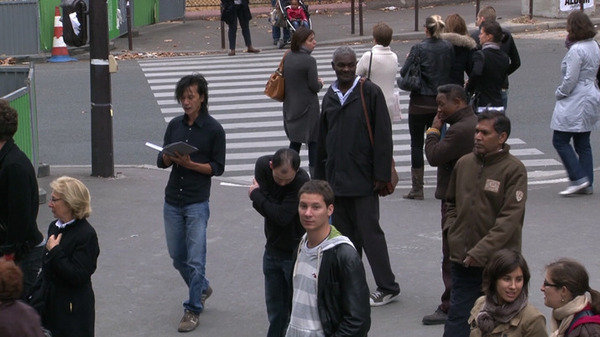The pursuit of public happiness?
dal 4/7/2014 al 1/8/2014
Segnalato da
Carlos Amorales
Michael Baers
Jeremiah Day
Annika Eriksson
Peter Friedl
Iman Issa
Martha Rosler
Christine Würmell
4/7/2014
The pursuit of public happiness?
Arratia, Beer, Berlin
The exhibition is conceived as a 'parliament of artworks,' staging a debate around two core questions, namely: What is the meaning of political community at a time when economic power appears to have trumped the sovereignty of nation states and supra-national bodies like the UN and what is its artistic representation?

curated by Christine Würmell
Carlos Amorales, Michael Baers, Jeremiah Day, Annika Eriksson, Peter Friedl, Iman Issa, Martha Rosler
In times of accelerated social, cultural and economic upheaval, how do artists and their artworks reflect on the public life of societies? Do they design proposals, participate, or do they withdraw to experiment with alternative forms of political praxis and analyse "things"? The group show The pursuit of public happiness? is conceived as a "parliament of artworks," staging a debate around two core questions, namely: What is the meaning of political community at a time when economic power appears to have trumped the sovereignty of nation states and supra-national bodies like the UN and what is its artistic representation?
The show'ss title is drawn from Hannah Arendt's "On Revolution," encountered both on a 2012 visit to Cairo where discussions of the book were in the air, and then importantly through the ongoing "Hannah Arendt Reading Group" in Berlin organized by the writer Fred Dewey. Dewey, a long-time colleague of Michael Baers, Jeremiah Day and myself, notes how Arendt's emphasis on public happiness can have "crucial significance for artists, writers, and anyone concerned with representation. It exposes how privatized and economic our notion of happiness has become, but also how a different notion of happiness, one that uses the word public, can clarify and bring to life complex representational questions."
In the American Declaration of Independence the term "the pursuit of happiness" reveals an ambivalence seized upon by Hannah Arendt, who in "On Revolution" refers to the dual nature of the phrase. It can be understood as meaning the primacy of the individual's right to their own private interests, economic and otherwise, or alternately, as the individual's inalienable right to participate in the political decision-making process. Founding a political project on this dual notion of happiness as economic/cultural freedom and the right to participate in politics transformed Elightenment ideas of free will and autonomy into a concrete political demand. "Freedom for them (the thinker's of the French Revolution)," writes Arendt, "could only exist in public; it was a tangible, worldly reality, something created be men to be enjoyed by men rather than a gift or a capacity, it was the man-made public space or market-place which antiquity had known as the area where freedom appears and becomes visible to all."
Perhaps today this same dual structure confronts us. But it has become visible now in the gap between the continued deployment of notions of happiness (in the double nature inherited from the period of Liberal revolution) as a central tenet of Western democracy and the ongoing foreclosure of the public space of politics (and economic mobility) by the neoliberal project.
The pursuit of public happiness? seeks to look at these questions through the work of various artists working in the present, but also past works. Using a variety of approaches, the participating artists confront this gap through a shared concern with discrepancies-between present and past uses of public space; between normative markers of democratic subjectivity and other marginalized politico-ethnic subjects; between the vacuousness of the graphical language employed in party politics and the equally empty programs they offer; between the notions emerging in particular historical epochs and their subsequent iteration.
By means of performative intervention, the foundation and governing principles of (modern) society are under scrutiny in Carlos Amorales (born 1970 in Mexico City) video Supprimer, Modifier et Preserver (2012) where different lawyers were asked to erase and modify a law they considered fundamental in a graphite version of the updated French Civil Code. Peter Friedl’s (born 1960 in Oberneukirchen, Austria) video work Liberty City (2007), (just) reverses the roles in an historical episode of urban racism (which took place in 1979 in a Roosevelt era built neighborhood for African-American residents). What appears as spontaneous video-documentation, is actually a meticulously constructed drama study. In a similarly recursive mode, Martha Rosler's (born 1943 in Brooklyn, New York) series of holiday cards (From Our House to Your House (1974-78)) portrays the artist in a variety of stereotypical feminine roles whose ideological nature is revealed not only by the inclusion of statistical information. Over three decades later, before the uprising and removal of long-term president Mubarak from office seemed possible, Iman Issa (born 1979 in Cairo) sets out to construct a set of minimal posters (Colors, Lines, Numbers, Symbols, Shapes, and Images (2010)) methodically probing the by then emptied out symbolic language of political election posters.
Christine Würmell
This exhibition was made possible with the generous support of Eidotech and team.
Image: Carlos Amorales, Supprimer, Modifier et Preserver, 2012. Video Still, 28:42 min
Arratia, Beer
Potsdamer Str. 87 - 10785 Berlin
Opening hours:
Tuesday–Saturday 12–6pm



